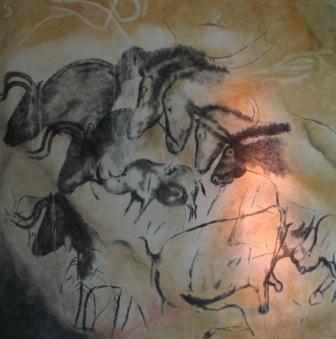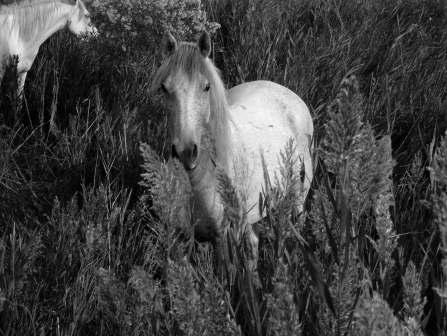Cheval Passion Avignon 2013 A Passion For The Camargue Horses Of Provence
By Bridget McArdle McKinney
Photo: Paintings from the Chauvet cave
(No part of this article may be copied or reproduced in any form without the permission of HT)
A BREED OF ANCIENT ORIGINS, SHORT, STRONG AND STOCKY, THE CAMARGUE HORSE OF THE RHONE DELTA MARSHLANDS OF PROVENCE, TAKES A UNIQUE PLACE IN HISTORY – FROM PROUD IMAGES FOUND IN PREHISTORIC CAVE PAINTINGS DATING BACK THOUSANDS OF YEARS TO THE BUILDING OF THE SUEZ CANAL IN THE 19TH CENTURY AND TODAY ON CENTER STAGE AT CHEVAL PASSION 2013.
LOOKING BEHIND THE SCENES:
We returned once again this January to enchanting Avignon to attend its annual horse fair, Cheval Passion (for our report on last year’s fair, please see HT Issue 38, “A Passion for Horses”). But instead of experiencing the adrenaline rush and excitement of the ‘Big Show’ on the weekend with the brilliantly lit and costumed horse cabarets and spectacles set to music, the pomp of the National Riding School and the Republican Guard cavalry, and the crowd-awing horse sports, we decided to come by a little early and take a look behind the scenes.
This time we watched the horse trainers, owners, and riders prepare and practice, groom and polish, fret and fuss. This was the time for the horse breeders and sellers to start showing their wares and striking their bargains and for the performers to get in one more drill, just one more run-through before the big day.
We started in the horse breeders’ barns: one for Iberian breeds; one for Arabs, Barbs, Lippizaners, and Sherpa Paca; and one for the home-grown breeds. It was here where we experienced the French love of the produce of the place, like local wine and cheese, lovingly and proudly produced products of their particular terroir.
HOME-GROWN FRENCH BREEDS:
Some of the French breeds we saw there in the show barns, which are recognized by the French national stud, the Haras Nationaux, include:
The Ardennes: Probably a descendant of the Solutré breed, the Ardennes is one of the oldest breeds of horses in France. From Roman times to the nineteenth century, this breed has responded to the needs of war and agriculture. Hardiness, sobriety, obedience, strength and endurance are still its main qualities.
The Auxois: Strongly related to the type Ardennais Auxois, it is the result of cross-breeding a local “Burgundy” with the standard Ardennes, Trait du Nord and, especially in the north, with some infusions of Percheron and Boulogne in the nineteenth century. Today, breeding is limited to the large Ardennais and Trait du Nord.
The Boulogne: This breed of horse is mentioned in chronicles from the seventeenth century and some trace the origin of this breed to the cavalry of Julius Caesar, raised in eastern Numidia and herded in 54 BCE near Boulogne for the war crossing to England. This breed was then re-tempered several times during the Crusades, the Spanish occupation and the first French Empire. They distinguish two types of Boulogne. The first type called “fishmongers”; lightweight, tough, very popular in the seventeenth and eighteenth centuries for the rapid transport of fish from Boulogne-sur-Mer to Paris. The second is a large and powerful horse, fashioned in the nineteenth century to work on sugar beet land and cartage.
Le Breton: The Breton horse today is the result of a long process of selection made by breeders from old varieties of native horses. Many crosses were made in the eighteenth and nineteenth centuries to improve these varieties, the most famous and most successful result of the mating of Norfolk stallion imported from Britain and Leon mares. This cross bore the “Postman Breton” whose fame spread worldwide.
The Norman Cob: The origin of the Norman Cob breed follows the Carrossier line until the mid- twentieth century. In the early nineteenth century the importation of Britain’s Norfolk bred to the Carrossière broodstock produced the excellent blood and confirmation of the prestigious Norman Cobb.
The Trait du Nord: The Trait du Nord is descended from the family of the Ardennes crossed with the Trait Belgian, which produced its size, weight, extra strength, and elegance and Trait Boulonnais, which provided its temperament. It was not until 1910 that the northern Ardennes established its independence as the Trait du Nord breed.
THE CAMARGUE OF PROVENCE:
But it was quite near here, near to Avignon, that one of the most recognized and romantic of the unique French breeds developed. In these fair barns we saw the best that the sea, marsh, dunes, wind and air produced in the Camargue, the sturdy and majestic Camargue horse of Provence.
For many people, the Camargue evokes an enduringly beautiful and fantastic image - a herd of wild sturdy greys galloping through the marshlands and over the dunes of the Bouches-du-Rhone. The origin of the breed is lost in the mists of time. It is reliably postulated that the Camargue is one of the oldest breeds in the world, its painted image captured by radio-carbon dating in the caves of southern France as long ago as 30,000 BCE (the Upper Paleolithic period). Its severe environment produced traits of endurance, agility, and strength for which it is known to this very day.
Domesticated by the sea-faring Phoenicians, its development was encouraged by Julius Caesar in the 1st Century BCE. The breed was exploited throughout the Middle Ages in the Rhone Delta area and, later, Napoleon recruited the Camargue to outfit his large army. It was truly amazing to learn, also, that this rugged breed was put into service in the building of Egypt’s Suez Canal in 1865!
The Camarguaise culture revolves around livestock and, in particular, the horses. The Camargue cow and bull herders, the Gardians and Gardiannes, live their ancient traditions in the present day through their food, clothing, music, dance and festivals. I asked my husband why there were so many people at the Avignon horse fair dressed up like Western ‘cowboys’. He said that the Western ‘cowboys’ are probably dressed up like the Gardians, whose leather chaps, wide-brimmed crushed felt hats, lassos, and roweled spurs sailed across to the Americas with the early Spanish explorers.
According to research, Camargue horses are always gray. This means that they have black skin underlying a white hair coat as adult horses. They are born with a hair coat that is black or dark brown in colour, but as they grow to adulthood, their hair coat becomes ever more intermingled with white hairs until it is completely white. They are small horses, generally standing 135–150 centimetres (13.1–14.3 hands) at the withers, and weighing 350 to 500 kg (770 to 1,100 lb).[2] Despite their small size, they have the strength to carry grown adults. Considered rugged and intelligent, they have a short neck, deep chest, compact body, well-jointed, strong limbs and a full mane and tail.
The head has many similarities to the Barb horse. It is often heavy, square and expressive, with bright, wide-set eyes, a straight profile, flat forehead and well-chiseled cheek bones.The ears are small, short, and set well apart. The forelock is full. The breed has a neck of medium length with an abundant mane. The chest is deep and wide, and the shoulder is powerful and muscular. The withers are defined but not exaggerated. The Camargue horse has a medium length back, well-supported, and a slightly sloping full croup, well-muscled hindquarters, and a low set, full tail. The Camargue horse has long legs which are well proportioned, strong and resistant, with large knees and hocks. Their hooves are hard and tough, with soles that are large and wide, suited to its original marshy habitat.
The calm temperament and athleticism of the Camargue horse has made it a popular choice for equestrian games, dressage, and long distance riding.
We really enjoy the Avignon horse fair. Every year we see and learn something new and amazing. On our day at the fair before the ‘big day’ we trod the grounds with the anxious owners, sellers, performers, and traders, marveled over the unique French horse breeds, and ended our day back home on the sea with some wine from our “terroir”. HT
*Contributing sources: L’Office de Tourisme d’Avignon, Cheval Passion Dossier de Press, Haras Nationaux, Wikipedia
--Ends--



